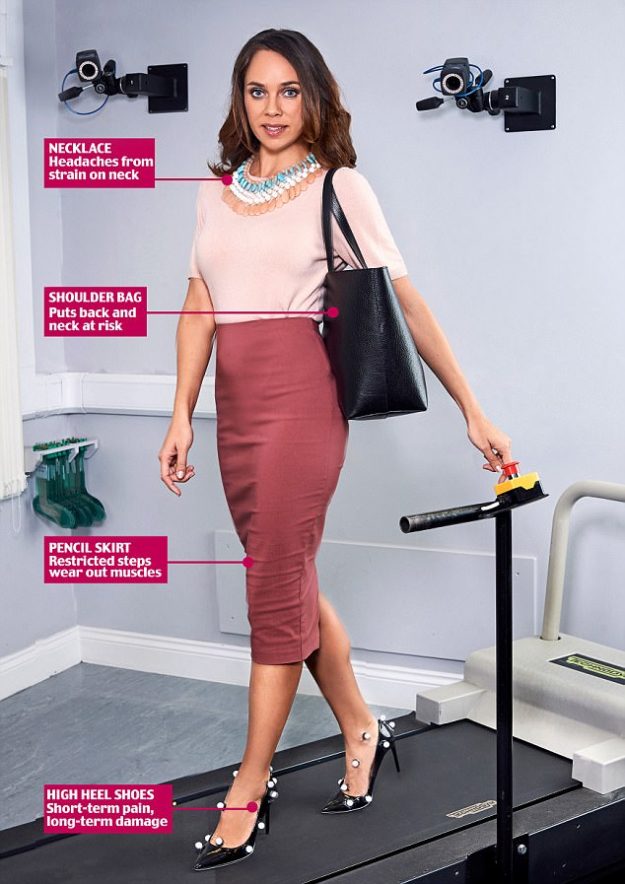
To find out more about the damage, Daily Mail went to London-based consultant podiatric surgeon Ron McCulloch, who observed a model wearing clothes which experts say could be detrimental and how they were twisting her figure out of shape.
Heavy necklace and headache
Fashionable as they may be, the weight of chunky necklaces can actually pull the neck forward. Ron gave the model a 300g piece and placed her on the pressure mapping mat to measure how her weight was distributed. “The necklace had altered her stance. She naturally stands with 40% of her weight on the left and 60% on the right, and it changed to 37% and 63% respectively. Even if the neck is pulled forward just a little, the posture is altered slightly,” he said.
This imbalance can contribute to discomfort and headaches or tensing of the muscles at the back of the neck to support the extra weight of the necklace. In the long-term, it may cause severe backache, imbalance and aching shoulders.
Skinny jeans and knee pain
These can have an impact on the knees, digestion and even blood circulation. “Our 3D assessment showed that when the model walked in skinny jeans, her knees didn’t extend correctly. Their movement was reduced by around 15%,” said Ron.
Very tight pants may eventually cause joint pain and with skinny jeans, that’s likely to be concentrated around knees. This can ultimately exacerbate arthritis and cartilage wear-and-tear.
“Tight clothing can affect circulation. The veins, which push blood back to the heart, may struggle,” Ron added. This could cause swollen ankles and problems such as pressure on nerves and tissues. And a tight waistband can impede digestion.
 PHOTO: DAILY MAIL
PHOTO: DAILY MAILBulky bags are handicaps
When we walk, we naturally sway from side to side. And if you’re holding something heavy, this sway increases, sending your posture out of kilter. “We’d say the ideal sway is below 30cm,” Ron said.
When the model was holding a heavy tote, her sway increased to 45cm. The bag altered her previously good gait and put her whole body in an uncomfortable position.
Unsurprisingly, the 3D scan showed she was raising her right shoulder to try to compensate for the weight. “She naturally has one leg longer than the other, as well as a very slightly increased collapsed arch on her left foot. As she walked, we could see that the forward and backwards movements of the hips weren’t balanced,” Ron explained. “There’s a risk of shoulder and neck pain or trapping a nerve, radiating pain into the arms or causing carpel tunnel syndrome.”
And as the spine isn’t being held straight, there’s a high chance of back pain and arthritis too.
Hell in high heels
The model stood strong in five-inch high court shoes and her postural sway is fine, which Ron attributes to her youth and general good health. But her toes were pushed down into the point of the shoe. And they were pushed even more in backless heels, which have no support around the ankles and heels.
Long-term, this can mean bunions, calluses and problems with the Achilles tendon. “I see many elderly ladies who’ve worn heels for years and now have permanently shortened calf muscles. When they wear flat shoes, their feet collapse at the arch, and, of course, heels increase the risk of falling over at any age,” said Ron.
Have something to add to the story? Share it in the comments below.


1732519298-0/BeFunky-collage-(85)1732519298-0-165x106.webp)
1732611352-0/lamar-(5)1732611352-0-165x106.webp)
1732610018-0/BeFunky-collage-(91)1732610018-0-165x106.webp)
1732607724-0/Express-Tribune-(4)1732607724-0-270x192.webp)
1732600740-1/Untitled-design-(1)1732600740-1-270x192.webp)










COMMENTS
Comments are moderated and generally will be posted if they are on-topic and not abusive.
For more information, please see our Comments FAQ